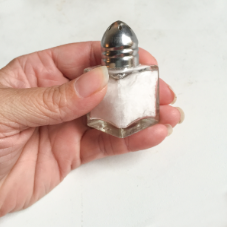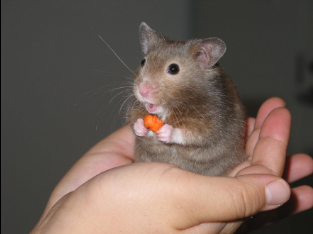16.1: Anchoring Units of Measurement
- Page ID
- 39940
Lesson
Let's see how big different things are.
Exercise \(\PageIndex{1}\): Estimating Volume
Estimate the volume of the tiny salt shaker.

Exercise \(\PageIndex{2}\): Cutting Strong
Your teacher will assign you one of the following lengths:
1 centimeter, 1 foot, 1 inch, 1 meter, or 1 yard.
Estimate and cut a piece of string as close to your assigned length as you can without using a measurement tool.
Exercise \(\PageIndex{3}\): Card Sort: Measurements
Your teacher will give you some cards with the names of different units of measurement and other cards with pictures of objects.
- Sort the units of measurement into groups based on the attribute they measure. Pause here so your teacher can review your groups.
- Match each picture card that has “L” in the top right corner with the closest unit to the length of the object.
- Match each picture card that has “V” in the top right corner with the closest unit to the volume of the object.
- Match each picture card that has “WM” in the top right corner with the closest unit to the weight or mass of the object.
Your teacher will assign you a new group to discuss how you matched the objects. If you disagree, work to reach an agreement.
Summary
We can use everyday objects to estimate standard units of measurement.
For units of length:
- 1 millimeter is about the thickness of a dime.
- 1 centimeter is about the width of a pinky finger.
- 1 inch is about the length from the tip of your thumb to the first knuckle.
- 1 foot is the length of a football.
- 1 yard is about the length of a baseball bat.
- 1 meter is about the length of a baseball bat and ball.
- 1 kilometer is about the distance someone walks in ten minutes.
- 1 mile is about the distance someone runs in ten minutes.
For units of volume:
- 1 milliliter is about the volume of a raindrop.
- 1 cup is about the volume of a school milk carton.
- 1 quart is about the volume of a large sports drink bottle.
- 1 liter is about the volume of a reusable water bottle.
- 1 gallon is about the volume of a large milk jug.
For units of weight and mass:
- 1 gram is about the mass of a raisin.
- 1 ounce is about the weight of a slice of bread.
- 1 pound is about the weight of a loaf of bread.
- 1 kilogram is about the mass of a textbook.
- 1 ton is about the weight of a small car.
Practice
Exercise \(\PageIndex{4}\)
Select the unit from the list that you would use to measure each object.
- The length of a pencil
- The weight or mass of a pencil
- The volume of a pencil
- The weight or mass of a hippopotamus
- The length of a hippopotamus
- The length of a fingernail clipping
- The weight or mass of a fingernail clipping
- The volume of a sink
- The volume of a bowl
- The length of a chalkboard or whiteboard
- The weight or mass of a chalkboard or whiteboard
- The length of the border between the United States and Canada
- centimeters
- cups
- feet
- gallons
- grams
- inches
- kilograms
- kilometers
- liters
- meters
- miles
- milliliters
- millimeters
- ounces
- pounds
- quarts
- tons
- yards
Exercise \(\PageIndex{5}\)
When this pet hamster is placed on a digital scale, the scale reads 1.5.

What could be the units?
Exercise \(\PageIndex{6}\)
Circle the larger unit of measure. Then, determine if the unit measures distance, volume, or weight (or mass).
- meter or kilometer
- yard or foot
- cup or quart
- pound or ounce
- liter or milliliter
- gram or kilogram
Exercise \(\PageIndex{7}\)
Elena mixes 5 cups of apple juice with 2 cups of sparkling water to make sparkling apple juice. For a party, she wants to make 35 cups of sparkling apple juice. How much of each ingredient should Elena use? Explain or show your reasoning.
(From Unit 2.5.1)
Exercise \(\PageIndex{8}\)
Lin bought 3 hats for $22.50. At this rate, how many hats could she buy with $60.00? If you get stuck, consider using the table.
| number of hats | price in dollars |
|---|---|
(From Unit 2.4.2)
Exercise \(\PageIndex{9}\)
Light travels about 180 million kilometers in 10 minutes. How far does it travel in 1 minute? How far does it travel in 1 second? Show your reasoning.
(From Unit 2.3.4)

